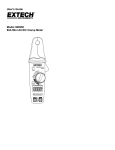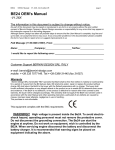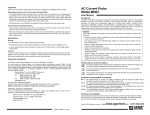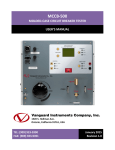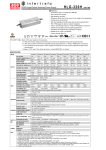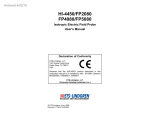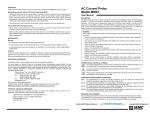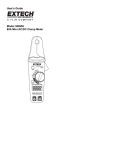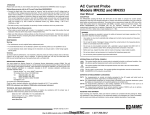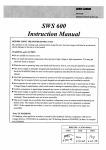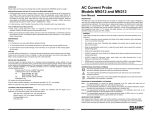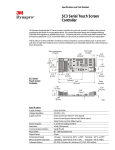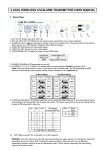Download 2610 Manual.indd - Chauvin Arnoux Group
Transcript
■ GROUND FAULT/LEAKAGE DETECTOR ENGLISH User Manual 2610 TABLE OF CONTENTS 1. INTRODUCTION ..............................................................2 1.1 Receiving Your Shipment..........................................................3 1.2 Packaging .................................................................................3 1.3 Ordering Information.................................................................3 1.3.1 Accessories and Replacement Parts............................3 2. PRODUCT FEATURES .....................................................4 2.1 Description................................................................................4 2.2 Compatibility .............................................................................5 3. SPECIFICATIONS ............................................................6 3.1 Specifications............................................................................6 3.1.1 Electrical .......................................................................6 3.1.2 Mechanical....................................................................7 3.1.3 Safety............................................................................7 4. OPERATION ....................................................................8 4.1 Principle of Operation ...............................................................8 4.1.1 Measuring Current Leakage .........................................8 4.1.2 Interpreting the Measurement.......................................8 4.2 Equipment Troubleshooting ....................................................10 4.3 Testing Various Cable Configurations..................................... 11 4.3.1 Metal Conduits ............................................................ 11 4.3.2 Grounded Neutral .......................................................12 4.3.3 Neutral Grounded Through an Impedance .................13 4.4 Commonly Asked Questions...................................................13 5. MAINTENANCE .............................................................14 5.1 Cleaning..................................................................................14 Repair and Calibration...........................................................................15 Technical and Sales Assistance ............................................................15 Limited Warranty ...................................................................................16 Warranty Repairs...................................................................................16 CHAPTER 1 INTRODUCTION Warning These safety warnings are provided to ensure the safety of personnel and proper operation of the instrument. • Never use this clamp on conductors with a voltage potential above 600Vrms. • Never clamp around a conductor unless the clamp is terminated to a measuring instrument of the proper input impedance. • Keep the jaw contacts clean. If necessary, use a slightly oiled cloth to remove oxidation. • Ensure that the cable or bus bar is properly centered within the clamp jaws. • Keep away from other conductors which may create interference. • Avoid leaving the clamp in damp places or exposing it to running water. • Due to shock or fire hazards, electrical connections of the instrument should be performed only by qualified personnel and in accordance with local, state, and federal electrical requirements. International Electrical Symbols This symbol signifies that the instrument is protected by double or reinforced insulation. Use only specified replacement parts when servicing the instrument. This symbol on the instrument indicates a WARNING and that the operator must refer to the user manual for instructions before operating the instrument. In this manual, the symbol preceding instructions indicates that if the instructions are not followed, bodily injury, installation/sample and product damage may result. Risk of electric shock. The voltage at the parts marked with this symbol may be dangerous. 2 Ground Fault/Leakage Detector Model 2610 1.1 Receiving Your Shipment Upon receiving your shipment, make sure that the contents are consistent with the packing list. Notify your distributor of any missing items. If the equipment appears to be damaged, file a claim immediately with the carrier and notify your distributor at once, giving a detailed description of any damage. Save the damaged packing container to substantiate your claim. 1.2 Packaging The Ground Fault/Leakage Detector Model 2610 is shipped with a user manual. 1.3 Ordering Information Ground Fault/Leakage Detector Model 2610 ...................... Cat. #1201.42 1.3.1 Accessories and Replacement Parts 4mm Safety Plug/Plug Adapter (converts male safety plugs to non-shielded male plugs) ... Cat. #1017.45 Ground Fault/Leakage Detector Model 2610 3 CHAPTER 2 PRODUCT FEATURES 2.1 Description The Model 2610 measures leakage current shunted to ground caused by insulation faults. It enables the operator to locate failures when or before they occur, without shutting down equipment or spending hours troubleshooting. It is designed specifically for locating low current faults on high current loads. The detector is a sensitive nickel alloy AC current transformer capable of measuring differential or leakage current from 500µA, and may be used to measure current up to 200A continuous duty (400A max). The Model 2610 provides, on two ranges, 1mV/mAAC or 1mV/AAC. The output leads are terminated with standard 4mm banana plugs capable of interfacing with any standard multimeter. Use of a digital multimeter with analog bar graph is recommended: Digital to provide the proper voltage input impedance, and an analog bar graph to track trends. When the 2610 is used as a current leakage detector, it makes no difference if the system is single-phase or poly-phase, or if the currents are in-phase or out of phase, balanced or unbalanced. The net magnetic field at any instant in time will be zero if all the conductors surrounded by the current leakage detector are supplying all the current delivered to and received from the load. If any current is diverted through any alternate path, such as an insulation breakdown to ground, the net loss will be detected producing a output proportional to the amplitude of the fault current. The Model 2610 may also be used simply as a highly accurate clamp-on current probe. With its 4” jaw opening and range of 500µA to 200A, the 2610 provides a versatile way to analyze unbalanced current measurements, leakage values on grounding conductors and ground loop currents. 4 Ground Fault/Leakage Detector Model 2610 2.2 Compatibility The Model 2610 is compatible with any DMM, voltmeter, or other voltage measuring instrument with the following features: • Range and resolution capable of displaying 1mVAC of input. • Voltmeter accuracy (uncertainty) of 0.75% or better to take full advantage of the accuracy of the probe. • Minimum input impedance of 1MΩ on the 4A range or 1kΩ on the 200A range. Connect the probe to the multimeter or other instrument. Select the appropriate AC voltage range on your multimeter. The Model 2610 has two selectable output ranges. The 4A range will produce a mV/mA with an output of 4VAC at 4A. The 200A range produces 1mV/A with 200mV at 200A. Warning: User Safety Always use a DMM, voltmeter or other displaying device, appropriately rated for safety. Ground Fault/Leakage Detector Model 2610 5 CHAPTER 3 SPECIFICATIONS 3.1 Specifications 3.1.1 ELECTRICAL 4A Range Current Range: 500µA to 4AAC Output Signal: 1mV/mA (4V max) Accuracy*: 500µA to 10mA: 3% of Reading + 1mA 10mA to 4A: 0.5% of Reading + 0.5mA Load Impedance: 1MΩ min 200A Range Current Range: 500mA to 200AAC (Between 200A and 400A, the max measurement time is 5 minutes with 20 minutes rest, @ 25°C [77°F] or less) Output Signal: 1mV/A (400mV max) Accuracy*: 0.5A to 10A: 0.5% of Reading + 0.5mA 10A to 200A: 0.5% of Reading + 0.5mA 200A to 400A: 0.5% of Reading + 1mA Load Impedance: 1kΩ min *Reference Conditions: Ambient temperature 23°C + 3°C, current frequency 48 to 65Hz, impedance of measuring instrument >10MΩ/100pF, absence of DC current in the conductor, conductor centered within the jaws. 6 Ground Fault/Leakage Detector Model 2610 3.1.2 MECHANICAL Frequency Range: 10 to 1000Hz (100A max at 1000Hz); 30Hz to 1kHz frequency limited to 100A to 1kHz Housing Protection Range: 20 (IEC 529) Shock Resistance: 100G (IEC 68-2-27) Vibration Resistance: 10/55/10Hz 0.15mm (IEC 68-2-6) Self-Extinguishing Ability: Handle: UL94 V0; Jaws: UL94 V2 Jaw Opening: 3.9” (100mm) Inside Jaw Diameter: 3.9” (100mm) Dimensions: 12.25 x 5.9 x 1.63” (31.1 x 15 x 4.1cm) Weight: 4.4 lbs (2kg) 3.1.3 SAFETY Dielectric Strength Test: 2kVAC Maximum Working Voltage: 600VAC �������������� �������� ������ �������� � � � ��������� ����� �������� Ground Fault/Leakage Detector Model 2610 ����� ������� 7 CHAPTER 4 OPERATION 4.1 Principle of Operation 4.1.1 Measuring Current Leakage When a generator supplies an AC load through a pair of wires in an insulated cable, the current going out on one wire is equal to the current returning; their vector sum equals zero. A ground fault changes this equality, and the leakage current detector picks it up, measures it, and provides an AC voltage output proportional to the severity of fault causing the unbalance. The ground conductor must not pass through the detector. 4.1.2 Interpreting the Measurement Figure 1 is a schematic of a single-phase installation of a motor and an oven, both grounded. The numbers indicate the amplitudes of the currents in different conductors. This installation has no faults. If you clamp the detector around the cables at points A,B,C or D, it will output zero. � ����� � �� �� �� �� � � � ���� ���� � � �� ����� �� �� ���� ��� ��� Figure 1 8 Ground Fault/Leakage Detector Model 2610 In Figure 2, there is a fault in the installation. At point A, the Model 2610 detects 1A (the difference between 16A and 15A), indicating a fault downstream. At point C, it detects zero; therefore, the fault is not in the oven. At points B and D, the detector picks up 1A, showing that the fault is in the motor. If it gets worse, the leakage current will increase and the circuit breaker will trip. This motor should be disconnected immediately and repaired. � ����� � �� �� �� �� � � � ���� � � � �� ����� �� � �� � ��� ��������������������� ��� Figure 2 In a three-phase installation the principle is the same. But here it is necessary to pass all active conductors through the detector, including the neutral if one is used. If this is done properly, the detector output will be zero if there is no current leaking to ground. If it detects something other than zero, there is a ground fault that should be repaired. 4.2 Equipment Troubleshooting To locate a fault quickly, begin your troubleshooting at the incoming lowvoltage distribution header. Successively check each feeder. If the Model 2610 detects a ground fault, follow the feeder downstream, branch by branch, to the equipment with the problem. Ground Fault/Leakage Detector Model 2610 9 It is useful to take measurements periodically to create a history of the quality of the insulation. This is good preventive maintenance which could prove valuable later. If you detect a fault current that is very low initially but increases from day to day, this means that electrical failure is imminent and should be taken care of during the next planned maintenance shutdown. For best results, center the conductors within the clamp jaws. Check that the edges of the jaws are perfectly clean and that they close tightly. Try to avoid placing the conductors near the gaps, and group them as much as possible. If you are careless, you can affect the magnitude of the reading, depending on the current being carried in the conductors. In certain cases this requires an interpretation. Normally, however, the absolute value of the ground current is not important. All you need to know is whether the reading is zero. 4.3 Testing Various Cable Configurations Older installations have a wide variety of electrical distribution systems. Cables are clamped to walls and pass through metal conduits, and there are many cases where a shielded cable was installed during revamping of an area or addition to a building. If a cable is clamped to walls, detach it and pull it away from the surface at several points, so the clamp can surround all the conductors. 4.3.1 Metal Conduits Cables enclosed in metal conduits which are grounded are not a problem. Simply apply the clamp around the conduit; the metal tube will not block the measurement. Cables with a metal shield can be handled in the same way as cable in metal conduit. A grounded shield may present a problem. If it is a simple metal shield, like a thin metal wrapping, it can be considered in the same way as the metal conduit. If the armor is grounded by a conductor, it may be an inconvenience, depending on the terminal connections, as well as on the number and type of ground connections along the cable. 10 Ground Fault/Leakage Detector Model 2610 In Figure 3 the detector senses the fault because the shield is not connected to the motor frame and the leakage current cannot flow back through the detector. In Figure 4, however, the instrument cannot “see” the fault because the shield is connected to the motor frame, letting the fault current return through the detector and causing it to read zero. If possible, take your measurement where you can avoid closing the shield in the clamp, such as the nearest control panel or inside the connecting box of the motor. Figure 3 Figure 4 One way to circumvent this shielded cable problem is shown in Figures 5 and 6. Here the shield is looped through the detector twice, so that the reading will be that of the fault current. Figure 5 Ground Fault/Leakage Detector Model 2610 Figure 6 11 4.3.2 Grounded Neutral It is easy to take measurements on this type of network, where major faults trip the circuit breaker. Here, the detector can sense minor faults, so repairs can be made before the problem gets worse. The inspection method is the same as for a single-phase installation. Remember that on a three-phase network, the currents add according to the vector sum law. The Model 2610 measures the vector sum of the enclosed currents. If you have, for example, a 400mA fault and a 250mA fault on the same phase, the Model 2610 will detect 650mA. But if the two faults are on different phases, they add vectorially and may even sum up to zero. Figure 7 shows an example in which there are two separate faults: 400mA on a machine in one shop, 250mA on a machine in another shop. The vector sum is not 650mA, but 350mA. If you switch off the machine with the 250mA fault, the reading increases, indicating faults on different phases. 4.3.3 Neutral Grounded Through an Impedance Follow the procedure the same way as for a grounded neutral installation, but with care. When the neutral is grounded through an impedance, a fault (even a serious one) may not trip the circuit breaker, and the shop will keep operating. 4.4 Commonly Asked Questions Q. I have found an indication of 40 to 50mA on one of the main feeders with 300A on the line. Is this value a fault? A. With 300A on the line, it is possible to find an undesired current of that magnitude. Different cables in the installation may not have equivalent capacitance and resistance. These cables provide for high current and, of course, we apply a high current. Therefore, we may have a capacitive influence which corresponds to 45mA. Q. Must the conductors be centered within the jaws? A. You should avoid placing the conductors close against the magnetic circuit near the gaps, and should group the conductors as much as possible. You must also ensure that the jaw ends are perfectly clean and that nothing prevents them from closing tightly. 12 Ground Fault/Leakage Detector Model 2610 Q. Is it possible when checking cables which run parallel, yet supply the same load, to clamp the detector over each cable separately? A. When there are parallel cables, the measurement is valid only if the detector covers the cables together. In fact, if you take each one separately, it is highly probable that the distribution of current in the parallel cables is not even. These differences can be caused by the fact that the cables may not have exactly the same resistance. Q. I have detected faults of 400mA and 250mA on branch circuits being supplied by the feeder. But clamping onto the incoming feeder resulted in an indication of 350mA. Can you explain why 400mA + 250mA = 350mA? A. The detector measures residual current; in other words, the vectorial sum of the currents. If you have a 400mA fault and a 250mA fault on the same phase, you have every chance of finding 650mA. But, if you have two faults on different phases, they add as vectors. In a very favorable theoretical case, we could even find zero. Q. The Model 2610 detects faults caused by insulation failures. How does detecting faults with the detector differ from information resulting from megohmmeter insulation tests? A. The Model 2610 will detect electrical faults while the equipment is still in operation. This offers two distinct advantages. First, it is not necessary to shut the equipment down, eliminating costly down time; and second, you may detect faults that would not be evident under static conditions. Q. Would it be possible to clamp the Model 2610 directly around the grounding detector? A. Yes, in some instances it may be possible to detect fault current on a specific motor if there is a dedicated grounding path. However, if several devices are sharing a common ground, it should be noted that the fault may be occurring on any one of the devices. Ground Fault/Leakage Detector Model 2610 13 CHAPTER 5 MAINTENANCE WARNING: • For maintenance use only specified replacement parts. • To avoid electrical shock, do not attempt to perform any servicing unless you are qualified to do so. • To avoid electrical shock and/or damage to the instrument, do not get water or other foreign agents into the case. Turn the instrument OFF and disconnect the unit from all the circuits before opening the case. 5.1 14 Cleaning • Wipe the case and jaw covers with a lightly moistened cloth and mild detergent. • Do not use any abrasives or solvents. • If rusted, the jaw mating surfaces of the Model 2610 may be lightly sanded with very fine sandpaper and then very lightly oiled. Wipe off excess oil and do not let it drip into the case. Ground Fault/Leakage Detector Model 2610 Repair and Calibration To ensure that your instrument meets factory specifications, we recommend that it be submitted to our factory Service Center at one-year intervals for recalibration, or as required by other standards or internal procedures. For instrument repair and calibration: You must contact our Service Center for a Customer Service Authorization Number (CSA#). This will ensure that when your instrument arrives, it will be tracked and processed promptly. Please write the CSA# on the outside of the shipping container. If the instrument is returned for calibration, we need to know if you want a standard calibration, or a calibration traceable to N.I.S.T. (Includes calibration certificate plus recorded calibration data). Chauvin Arnoux®, Inc. d.b.a. AEMC® Instruments 15 Faraday Drive Dover, NH 03820 USA Tel: (800) 945-2362 (Ext. 360) (603) 749-6434 (Ext. 360) Fax: (603) 742-2346 or (603) 749-6309 [email protected] (Or contact your authorized distributor) Costs for repair, standard calibration, and calibration traceable to N.I.S.T. are available. NOTE: All customers must obtain a CSA# before returning any instrument. Technical and Sales Assistance If you are experiencing any technical problems, or require any assistance with the proper operation or application of your instrument, please call, mail, fax or e-mail our technical support hotline: Chauvin Arnoux®, Inc. d.b.a. AEMC® Instruments 200 Foxborough Boulevard Foxborough, MA 02035, USA Phone: (800) 343-1391 (508) 698-2115 Fax: (508) 698-2118 [email protected] www.aemc.com NOTE: Do not ship Instruments to our Foxborough, MA address. Ground Fault/Leakage Detector Model 2610 15 Limited Warranty The Model 2610 is warranted to the owner for a period of one year from the date of original purchase against defects in manufacture. This limited warranty is given by AEMC® Instruments, not by the distributor from whom it was purchased. This warranty is void if the unit has been tampered with, abused or if the defect is related to service not performed by AEMC® Instruments. For full and detailed warranty coverage, please read the Warranty Coverage Information, which is attached to the Warranty Registration Card (if enclosed) or is available at www.aemc.com. Please keep the Warranty Coverage Information with your records. What AEMC® Instruments will do: If a malfunction occurs within the one-year period, you may return the instrument to us for repair, provided we have your warranty registration information on file or a proof of purchase. AEMC® Instruments will, at its option, repair or replace the faulty material. REGISTER ONLINE AT: www.aemc.com Warranty Repairs What you must do to return an Instrument for Warranty Repair: First, request a Customer Service Authorization Number (CSA#) by phone or by fax from our Service Department (see address below), then return the instrument along with the signed CSA Form. Please write the CSA# on the outside of the shipping container. Return the instrument, postage or shipment pre-paid to: Chauvin Arnoux®, Inc. d.b.a. AEMC® Instruments Service Department 15 Faraday Drive • Dover, NH 03820 USA Tel: (800) 945-2362 (Ext. 360) (603) 749-6434 (Ext. 360) Fax: (603) 742-2346 or (603) 749-6309 [email protected] Caution: To protect yourself against in-transit loss, we recommend you insure your returned material. NOTE: All customers must obtain a CSA# before returning any instrument. 16 Ground Fault/Leakage Detector Model 2610 12/03 99-MAN 100088 v3 Chauvin Arnoux®, Inc. d.b.a. AEMC® Instruments 15 Faraday Drive • Dover, NH 03820 USA • Phone: (603) 749-6434 • Fax: (603) 742-2346




















